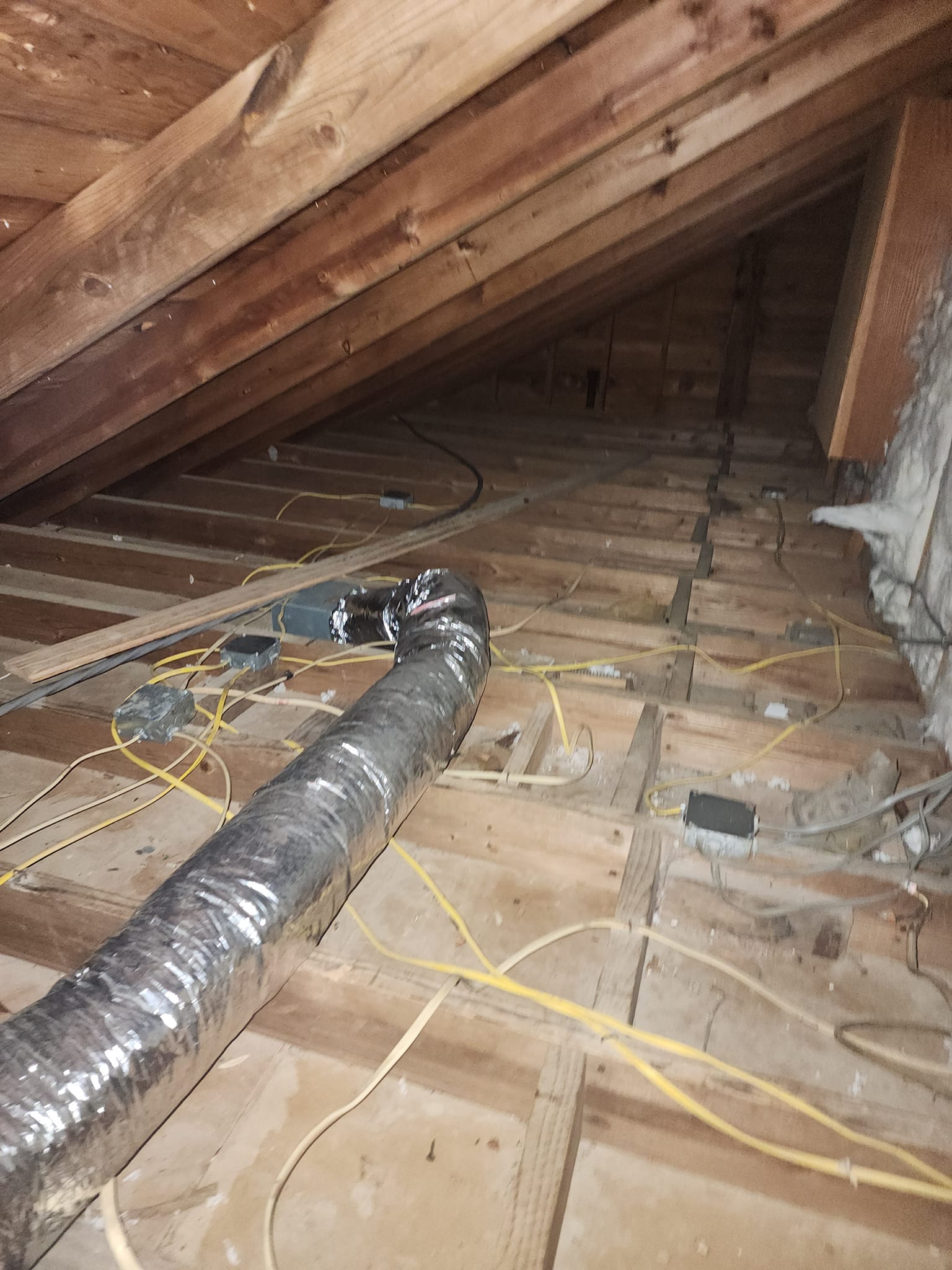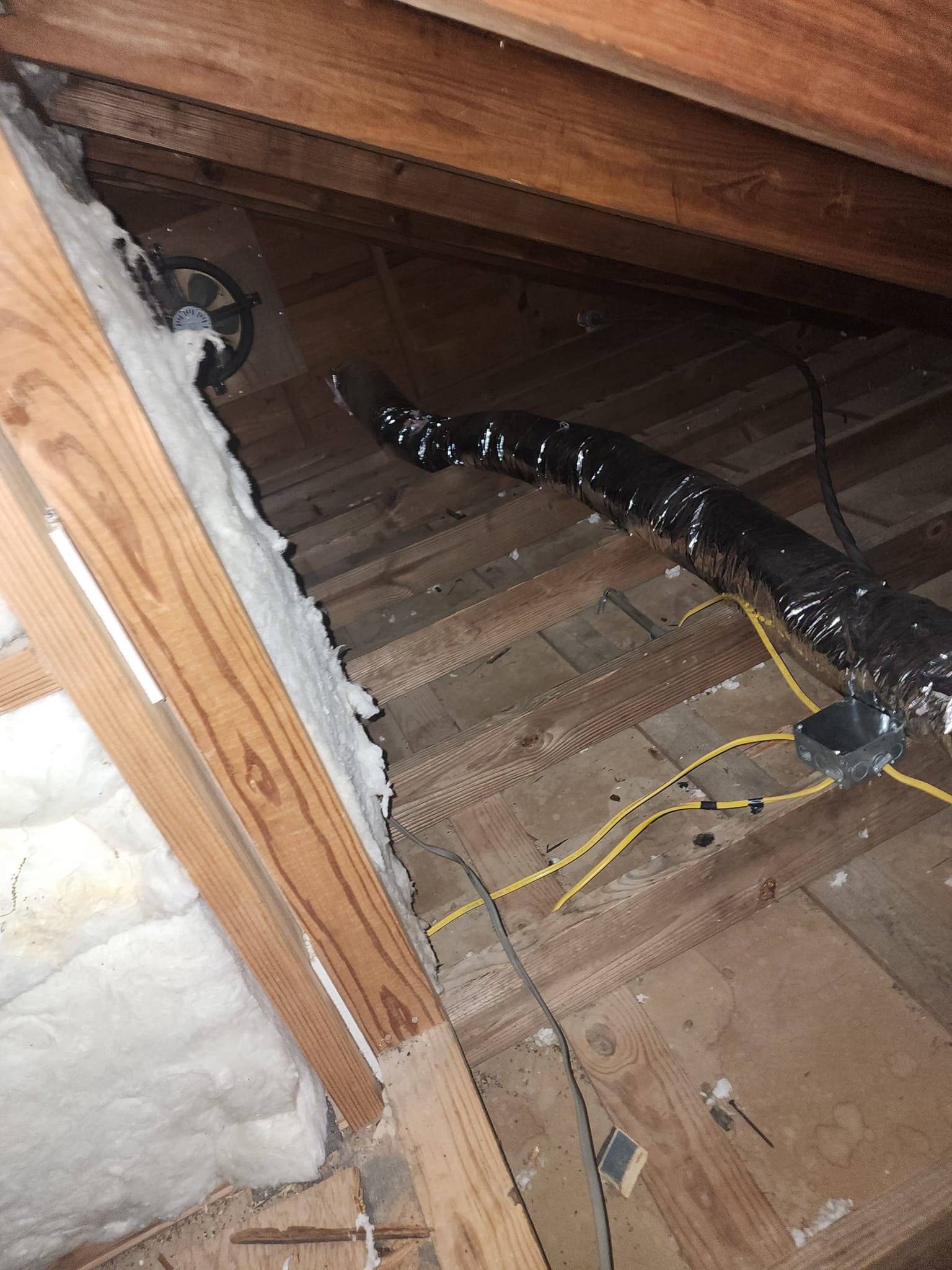How should I prepare a knee wall attic for 12 inches of blow-in insulation while relocating junction boxes and adding a catwalk, and is there anything else to consider?
9 months ago
Last Updated: September 9, 2024
How would you tackle getting this knee wall attic ready for 12 inches of blow in insulation? Moving the junction boxes above the insulation? Putting in a catwalk? Anything else we should consider? Thanks and happy new year!


Make sure to snap plenty of photos and label the rafters where the junction boxes are located on the ceiling joists.
I was starting to think that . I can’t wait to get the insulation in and finish up these projects.
‘t stress, just strut that catwalk, hit a few marks, and fill ‘er up!
Make sure to seal all top plates properly and install ventilation shoots in the soffits. Use fiberglass damming rated at r38 around the hatch and bath fan. Apply high heat caulk around any gaps in the bath fan. Consider placing small flags above the junction boxes to make them easily visible.
Block off the floor lines leading into that area using either foam board and securing them tightly on all four sides, or purchase spray foam to seal them off. ‘t forget to air seal around electrical and plumbing holes, as well as the bath fan. Tyvek the walls with unfaced insulation. If there are slopes above the kneewall, cover them with spray or foam board. As for a catwalk, it’s not necessary – just be cautious and stick to the joists when moving around. Remember to flag junction boxes for easy identification in the future.
Also, do you have built-in cabinets in there? If yes, insulate them using foam and adhesive caulk. Make sure to insulate access doors and add 1×2’s and foam roll to them.
Yep, there are indeed some built-in shelves and “closet” spaces. Much appreciated!
Hey, I recently had some foam board blocking installed between the joists under the floors, with some spray foam around them. The insulation company I consulted with is suggesting blowing insulation underneath the floors. Personally, I prefer sealing off each section with the foam board.
Having heated space under the floor and heated space above the floor seems unnecessary to insulate between floors. I work as an insulator and I’ve never done it that way before. It doesn’t mean it’s incorrect, but it seems like a waste of material and time. Unless you’re aiming to add soundproofing.
You mentioned Tyvek on the walls, I was thinking of using foam board and ensuring it’s well foamed up. The issue is that the wires run alongside the walls and not through the studs, if that makes sense. I would mark where the wires are located. I know the 2-inch boards have a higher R-value, but I was considering 3/4 polystyrene boards for budget reasons. Would it be okay for the wires to directly touch the foam board? There’s a gap above the knee wall where the room ceilings are. Some old fiberglass batts are there, not completely filling the void. I wasn’t planning on touching those so that the attic space could vent out through the ridge. I really appreciate you taking the time to answer my questions.
No problem at all, I enjoy sharing knowledge about my trade. It’s up to you if you want to include foam board on those walls (in my humble opinion) it may not be worth the cost. Adding house wrap will create an air barrier to help prevent cold air from seeping into the existing fiberglass insulation. Leaving the slopes open isn’t a bad idea, some say fill them, others say leave them venting for the collar beam attic. Personally, I would fill them as long as there is ventilation in the kneewall attics and (main) collar beam attic. This is because there’s only 4 inches between your heated space and the unheated space where the slopes are. Hopefully, that makes sense.
I wish I had shared this before getting my roof done and hearing your thoughts! I could have avoided installing the ridge and instead added exhaust vents lower down on the roof. I did a lot of research beforehand, but all the roofers I spoke with recommended a ridge vent. In my area, there are only three insulation companies. One didn’t even bother calling me back, another suggested spray foam which was way over budget, and the one I ended up working with has been quite difficult to deal with. It seems like attic ventilation and insulation for older houses like mine isn’t a topic that’s talked about much around here.
We often install roof vents in attics. This ensures that the main attic has proper ventilation, and then we add appropriate vents to kneewalls. Sometimes we also add gable wall vents to kneewall walls if the soffit is not vented.
In this photo, you can see where I used to have exhaust fans on each side. I had them disconnected and covered up outside while getting part of the siding fixed. The fans were just blowing hot air into an attached carport with no ridge vent for it to escape. I was thinking about adding gable vents for intake, but I’ve heard they’re not always reliable. Plus, there wouldn’t be much wind to help push air in and out the ridge. Maybe I’ll ask the roofer about adding vents lower on the roof and higher up to vent out the knee wall spaces.
Just like Sandy mentioned, go ahead and mark the spots where the junction boxes are located. It’s probably not necessary to move them since you likely won’t need to access them often, but at least you’ll have a general idea of where they are in case you do need to. I haven’t heard of anyone moving a junction box before.
This is crucial – install vent baffles at the base of the rafters to prevent blown insulation from blocking airflow from the soffit. The sight of wires running all over can be frustrating, but since you won’t be in that space frequently, you can leave them as is. However, double-check that all HVAC vents are properly connected and sealed while there is still clear access. You can also mark the general location of junction boxes on the rafter above each one for future reference.
I used to have an attic similar to this one. Definitely had a catwalk!
Seems to be leaning towards this idea. I never know for sure, but I enjoy tinkering and building things when I’m feeling well. I previously had a platform constructed in the other knee wall using 2x6s over the joists and osb to create an approximately 8×7 platform for storage. I was considering doing something similar by creating a 16-inch wide catwalk that spans the attic.
Absolutely. Consider putting in the 2x6s, doing the blow-in insulation, and then laying the platform. If you want to get really detailed, you can even build trusses out of furring strips to reduce extra weight. It might be a bit much, but it could be a fun project to tackle.
Make sure to do the catwalk FIRST to help the insulation installer and show your support. Not sure how to install your supports? No worries, your knee wall framing will work. I installed my catwalk along the entire length of my house and it’s been really helpful. Just make sure to install it a few inches above your projected insulation depth in case you need to do work up there later.
The person who will install it, would really appreciate it if you also have insulation inside the catwalk.
I had no trouble insulating the attic under my catwalk since it’s floating. Blown insulation is the best option in my opinion.
I was planning on making the frame 16 inches wide, adding some blocking for stability. Then I’ll fill it with blow-in insulation and cover it with OSB.
Using an anonymous participant should be fine, no worries! Feel free to get creative with it, except for the catwalk platform. The sides are open, so you can just go for it. I personally put a horizontal 2x across and attached it to two truss members, then placed a 16″ plywood on top. It’s completely open underneath.
That’s interesting. How do you go about floating a catwalk without compressing the insulation? Are you considering anchoring it to something other than the joists?
I used trusses and just placed a 2×4 across at around 16″ up and connected it to two truss members. Then I placed the catwalk on top of that.
Oh, yeah. Totally makes sense if you’ve got the room for it. The attic I had before only had about 4 feet of clearance at most.
I had just enough space with a 4:12 roof pitch and a 28 ft wide house to crawl up there and do whatever I needed to before they insulated!
Yep, make sure to install what they call proper vents to maintain airflow from the soffits into the attic. Repeat this process in every gap between the rafters.
If the NM cable has some slack, use masons twine to elevate it above the finished insulation. Secure the twine to a nearby framing for support. Then, insulate the area. Trim the twine at the top so the NM cable sits on top of the insulation. Make sure to sand the OSB edges to remove any sharp splinters.
Pairing http://www.AtticFoil.com radiant barrier with extra insulation can enhance its effectiveness.
I typically do not recommend radiant barrier in an attic setting. Once it becomes dusty/dirty, the ‘radiant’ feature essentially diminishes. Attics tend to be environments where dust accumulates rapidly. While the scientific basis exists, in practical terms and in that specific setting in my opinion, it’s not effective.
Thanks for getting back to me. However, this is a common misconception since many people lack a full understanding of the physics behind a radiant barrier. If you are familiar with radiant barrier decking materials (which are mandatory in many regions) like TechShield. The foil side is placed at the BOTTOM of the OSB facing the attic airspace. These barriers actually rely on the emissivity characteristic rather than reflectivity. http://www.AtticFoil.com is dual-sided. The upper side functions based on reflectivity, while the lower side operates based on emissivity. So, even if the top side gathers a lot of dust, the bottom side utilizing emissivity will remain unaffected. Essentially, a significant amount of dust/dirt on the top side would essentially create Techshield or radiant barrier decking.
I guess I have to respectfully disagree … your link seemed more like a sales pitch/advertisement rather than providing scientific information about the argument you presented. The underside will also accumulate dust/dirt. I acknowledge the benefits, but typically they are not as significant as claimed and therefore, in my opinion, not worth the cost/hassle of installation. While it will enhance effectiveness, is it worth the expense? In my opinion, no. That’s why I wouldn’t and don’t suggest it.